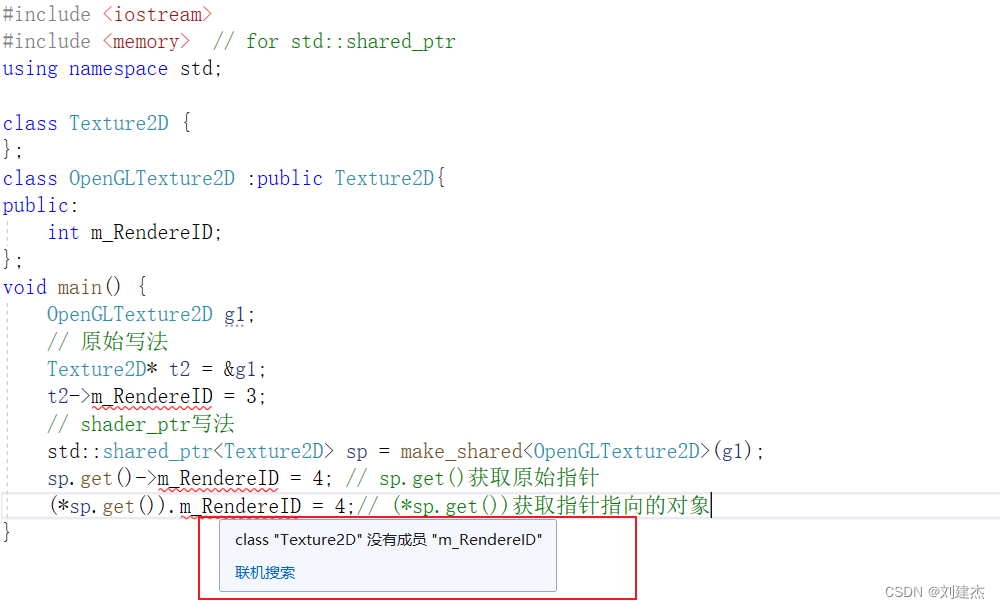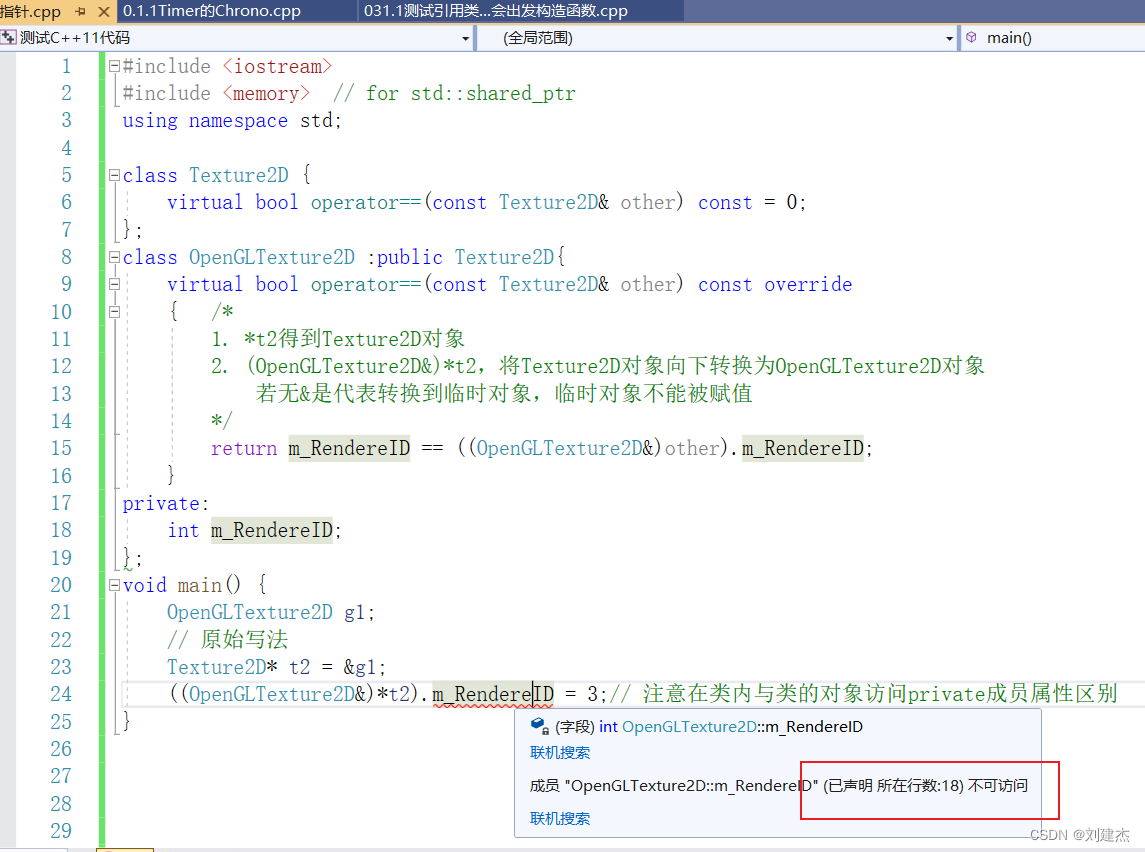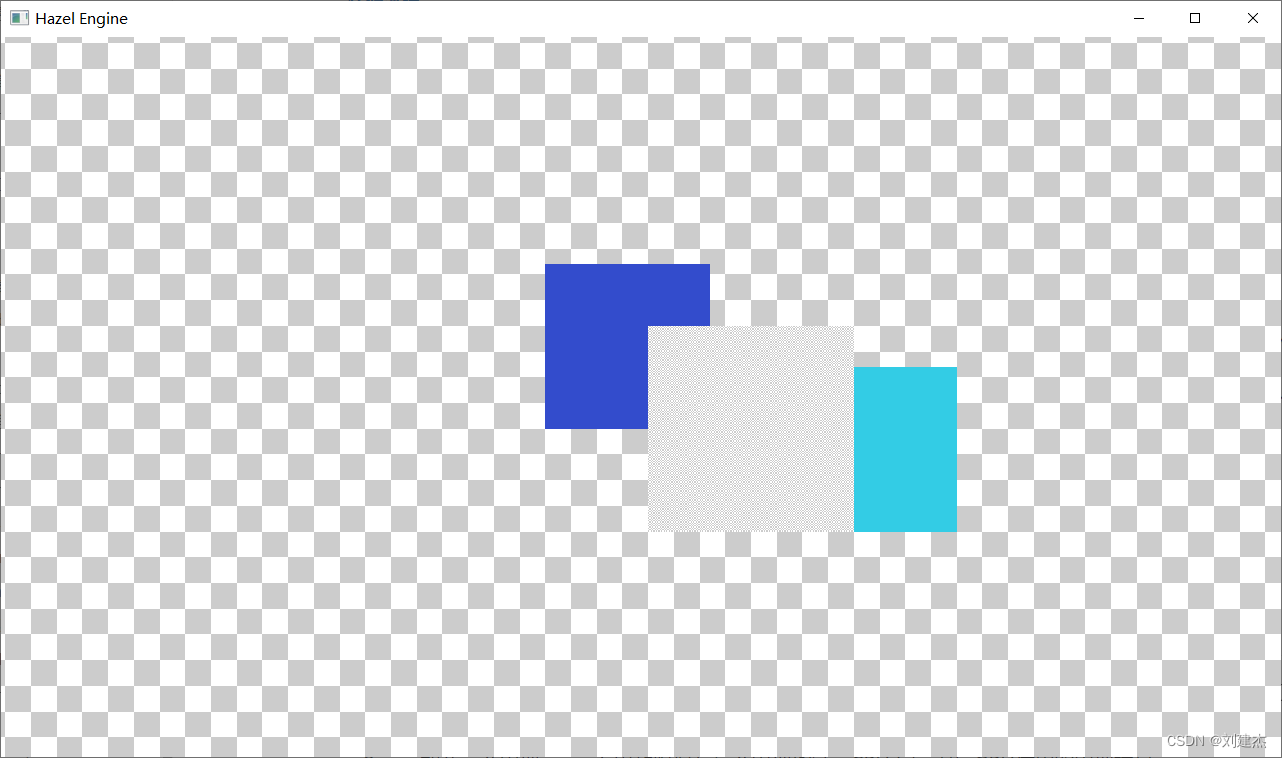文中若有代码、术语等错误,欢迎指正
前言
-
回顾纹理采样个人理解。
- 加载纹理资源,设置这个纹理资源开辟的缓冲区m_RendererID绑定在纹理槽0号上
- glsl上采样的纹理,在纹理槽0号上采样,纹理槽0号指向了第1步的纹理资源,这样就完成对这个加载的纹理采样。
-
OpenGL的纹理槽
OpenGL限制了一次drawcall能使用多少个纹理槽,通常是32个
但若想超过32有40个纹理需要使用,可以:
- 分两次,第一次drawcall32个,然后清空重新加载纹理再drawcall
- 通过绕开GPU32个纹理的限制,这个比较难。
- 用纹理集,texture altas
此节是一次drawcall使用固定32个纹理槽。
大致流程
-
先提前为此次的shader上传一个默认的大小为32的采样数组
u_Textures[i] = j,其中i = j,u_Textures[1] = 1表示片段着色器采样纹理槽1号上的纹理
而纹理槽1号上的纹理缓冲区ID是不是等于1可以不用关心。
-
加载一个纹理得到纹理对象,用数组保存这个纹理对象
-
在绘制带有纹理的quad图形时,判断数组中是否有这个纹理对象
有就取出 i 下标
没有就加在数组已有纹理的末尾,并且记录下标 i
-
设置当前顶点采样的纹理单元是 i,后续会将这个纹理槽号 i 从顶点阶段传入到fragment片段着色器阶段
-
在Drawcall前,TextureSlots数组上存储已经加载的纹理,按照顺序依次绑定到对应的纹理槽上
-
Drawcall时,在片段着色器上,读取采样对应纹理槽号i上的纹理
代码流程
-
先记住数据结构
-
std::array<Ref, MaxTextureSlots> TextureSlots;
是一个32大小的数组,数组的元素是纹理对象指针,用来存储加载好了的纹理对象的
-
int32_t samplers[s_Data.MaxTextureSlots];
是一个32大小的数组,数组的元素是int值,用来上传给glsl的
-
-
先提前为此次的shader上传一个默认的大小为32的采样数组,u_Textures[i] = j, 其中i = j,u_Textures[1] = 1表示采样纹理槽1号上的纹理
// 纹理的shader s_Data.TextureShader = Shader::Create("assets/shaders/Texture.glsl"); int32_t samplers[s_Data.MaxTextureSlots]; for (uint32_t i = 0; i < s_Data.MaxTextureSlots; i++) { samplers[i] = i; } s_Data.TextureShader->Bind();// 上传数据前要先绑定shader // 为TextureShader上传一个默认的大小为32的采样数组,u_Textures[i] = j,其中i = j,u_Textures[1] = 1表示采样纹理槽1号上的纹理 s_Data.TextureShader->SetIntArray("u_Textures", samplers, s_Data.MaxTextureSlots); -
加载一个纹理得到纹理对象,用数组保存这个纹理对象
// 白色纹理 // 创建一个白色Texture s_Data.WhiteTexture = Texture2D::Create(1, 1); uint32_t whiteTextureData = 0xffffffff; s_Data.WhiteTexture->SetData(&whiteTextureData, sizeof(uint32_t)); // 0号纹理槽对应白色纹理缓冲区 s_Data.TextureSlots[0] = s_Data.WhiteTexture; -
在当前绘制quad图形时,判断TextureSlots数组是否有这个纹理,有就取出 i 下标,没有就加在数组已有纹理的末尾,并且记录下标 i
float textureIndex = 0.0f; for (uint32_t i = 1; i < s_Data.TextureSlotIndex; i++) { // 当前纹理,如果已经存储在纹理槽,就直接读取 if (*s_Data.TextureSlots[i].get() == *texture.get()) { textureIndex = (float)i; break; } } if (textureIndex == 0.0f) { textureIndex = (float)s_Data.TextureSlotIndex;// 代表在数组中没有纹理对象的位置 s_Data.TextureSlots[s_Data.TextureSlotIndex] = texture; s_Data.TextureSlotIndex++;// 记得++ } // 设置当前顶点采样的纹理单元是 **i** -
在顶点数据数组设置当前顶点采样的纹理单元是 i,后续在第6步会将这个纹理槽号 i 传入到fragment阶段
// quad的左下角为起点 s_Data.QuadVertexBufferPtr->Position = position; s_Data.QuadVertexBufferPtr->Color = color; s_Data.QuadVertexBufferPtr->TexCoord = { 0.0f, 0.0f }; s_Data.QuadVertexBufferPtr->TexIndex = textureIndex; // 采样的纹理槽号 s_Data.QuadVertexBufferPtr->TilingFactor = tilingFactor; s_Data.QuadVertexBufferPtr++;glsl相关
s_Data.QuadVertexBuffer->SetLayout({ { Hazel::ShaderDataType::Float3, "a_Position"}, { Hazel::ShaderDataType::Float4, "a_Color"}, { Hazel::ShaderDataType::Float2, "a_TexCoord"}, { Hazel::ShaderDataType::Float, "a_TexIndex"}, { Hazel::ShaderDataType::Float, "a_TilingFactor"} });// 顶点布局 #type vertex #version 330 core layout(location = 0) in vec3 a_Position; layout(location = 1) in vec4 a_Color; layout(location = 2) in vec2 a_TexCoord; layout(location = 3) in float a_TexIndex; layout(location = 4) in float a_TilingFactor; -
在Drawcall前,TextureSlots数组上存储已经加载的纹理,按照顺序依次绑定到对应的纹理槽上
这样就与第3、4步设置当前顶点采样的纹理槽号i是TextureSlots数组上的i号纹理
void Renderer2D::Flush() { // 对应i的texture绑定到i号纹理槽 for (uint32_t i = 0; i < s_Data.TextureSlotIndex; i++) { s_Data.TextureSlots[i]->Bind(i); } RenderCommand::DrawIndexed(s_Data.QuadVertexArray, s_Data.QuadIndexCount); } -
Drawcall时,在片段着色器上,读取采样对应纹理槽号i上的纹理
#type fragment #version 330 core layout(location = 0) out vec4 color; in vec4 v_Color; in vec2 v_TexCoord; in float v_TexIndex;// 从顶点着色器传入,在cpp代码的drawquad函数中设置 in float v_TilingFactor; // 纹理槽号数组u_Textures[i] = j, 其中i = j,u_Textures[1] = 1表示采样纹理槽1号上的纹理 uniform sampler2D u_Textures[32]; void main() { // 采样纹理槽v_TexIndex号上的纹理 color = texture(u_Textures[int(v_TexIndex)], v_TexCoord * v_TilingFactor) * v_Color; //color = v_Color; }
注意bug
-
上传Shader数据前要先绑定
s_Data.TextureShader->Bind();// 上传数据前要先绑定shader s_Data.TextureShader->SetIntArray("u_Textures", samplers, s_Data.MaxTextureSlots); -
glsl里u_color与v_color不要用混
-
去除glsl上的无关变量
问题
为什么Texture重载==运算符
Texture2D
virtual bool operator==(const Texture2D& other) const = 0;
OpenGLShader
virtual bool operator==(const Texture2D& other) const override
{
return m_RendererID == ((OpenGLTexture2D&)other).m_RendererID;
}
void Renderer2D::DrawrRotatedQuad(const glm::vec3& position, const glm::vec2& size, float rotation, const Ref<Texture2D>& texture, float tilingFactor, const glm::vec4& tintColor)
{
HZ_PROFILE_FUNCTION();
constexpr glm::vec4 color = {
1.0f, 1.0f, 1.0f, 1.0f };
float textureIndex = 0.0f;
for (uint32_t i = 1; i < s_Data.TextureSlotIndex; i++)
{
// 当前纹理,如果已经存储在纹理槽,就直接读取
// 使用了 == 运算符,对比m_RendereID是否相同
// TextureSlots数组的元素是Texture2D父类指针,而texture也是Texture2D父类指针
if (*s_Data.TextureSlots[i].get() == *texture.get()) {
textureIndex = (float)i;
break;
}
}
-
TextureSlots数组的元素是Texture2D父类指针
-
而texture也是Texture2D父类指针
-
但是m_RendererID是OpenGLTexture2D子类的私有变量,且父类Texture2D无m_RendererID属性
-
所以无法写*s_Data.TextureSlots[i].get().m_RendererID == *texture.get().m_RendererID

所以只能通过重载==运算符,然后再转换为子类对象,再访问私有成员属性进行对比

结果

完整代码
Texture.glsl
// 纹理的glsl
#type vertex
#version 330 core
layout(location = 0) in vec3 a_Position;
layout(location = 1) in vec4 a_Color;
layout(location = 2) in vec2 a_TexCoord;
layout(location = 3) in float a_TexIndex;
layout(location = 4) in float a_TilingFactor;
uniform mat4 u_ViewProjection;
out vec4 v_Color;
out vec2 v_TexCoord;
out float v_TexIndex;
out float v_TilingFactor;
void main() {
v_Color = a_Color;
v_TexCoord = a_TexCoord;
v_TexIndex = a_TexIndex;
v_TilingFactor = a_TilingFactor;
gl_Position = u_ViewProjection * vec4(a_Position, 1.0);
}
#type fragment
#version 330 core
layout(location = 0) out vec4 color;
in vec4 v_Color;
in vec2 v_TexCoord;
in float v_TexIndex;
in float v_TilingFactor;
uniform sampler2D u_Textures[32];
void main() {
color = texture(u_Textures[int(v_TexIndex)], v_TexCoord * v_TilingFactor) * v_Color;
//color = v_Color;
}
Renderer2D.cpp
#include "hzpch.h"
#include "Renderer2D.h"
#include "VertexArray.h"
#include "Buffer.h"
#include "Shader.h"
#include "Texture.h"
#include "RenderCommand.h"
#include <glm/gtc/matrix_transform.hpp>
namespace Hazel {
struct QuadVertex {
glm::vec3 Position;
glm::vec4 Color;
glm::vec2 TexCoord;
float TexIndex;
float TilingFactor;
};
struct Renderer2DData {
const uint32_t MaxQuads = 10000;
const uint32_t MaxVertices = MaxQuads * 4;
const uint32_t MaxIndices = MaxQuads * 6;
static const uint32_t MaxTextureSlots = 32; // 最大的纹理槽数
Ref<VertexArray> QuadVertexArray;
Ref<VertexBuffer> QuadVertexBuffer;
Ref<Shader> TextureShader;
Ref<Texture2D> WhiteTexture;
uint32_t QuadIndexCount = 0;
QuadVertex* QuadVertexBufferBase = nullptr;
QuadVertex* QuadVertexBufferPtr = nullptr;
std::array<Ref<Texture2D>, MaxTextureSlots> TextureSlots;
uint32_t TextureSlotIndex = 1;// 0 号给白色纹理
};
static Renderer2DData s_Data;
void Hazel::Renderer2D::Init()
{
HZ_PROFILE_FUNCTION();
// 0.在CPU开辟存储s_Data.MaxVertices个的QuadVertex的内存
s_Data.QuadVertexBufferBase = new QuadVertex[s_Data.MaxVertices];
// 1.创建顶点数组
s_Data.QuadVertexArray = VertexArray::Create();
// 2.创建顶点缓冲区,先在GPU开辟一块s_Data.MaxVertices * sizeof(QuadVertex)大小的内存
// 与cpu对应大,是为了传输顶点数据
s_Data.QuadVertexBuffer = VertexBuffer::Create(s_Data.MaxVertices * sizeof(QuadVertex));
// 2.1设置顶点缓冲区布局
s_Data.QuadVertexBuffer->SetLayout({
{
Hazel::ShaderDataType::Float3, "a_Position"},
{
Hazel::ShaderDataType::Float4, "a_Color"},
{
Hazel::ShaderDataType::Float2, "a_TexCoord"},
{
Hazel::ShaderDataType::Float, "a_TexIndex"},
{
Hazel::ShaderDataType::Float, "a_TilingFactor"}
});
// 1.1顶点数组添加顶点缓冲区,并且在这个缓冲区中设置布局
s_Data.QuadVertexArray->AddVertexBuffer(s_Data.QuadVertexBuffer);
// 3.索引缓冲
//uint32_t flatIndices[] = { 0, 1, 2, 2, 3, 0 };
uint32_t* quadIndices = new uint32_t[s_Data.MaxIndices];
// 一个quad用6个索引,012 230,456 674
uint32_t offset = 0;
for (uint32_t i = 0; i < s_Data.MaxIndices; i += 6) {
quadIndices[i + 0] = offset + 0;
quadIndices[i + 1] = offset + 1;
quadIndices[i + 2] = offset + 2;
quadIndices[i + 3] = offset + 2;
quadIndices[i + 4] = offset + 3;
quadIndices[i + 5] = offset + 0;
offset += 4;
}
Ref<IndexBuffer> flatIB = IndexBuffer::Create(quadIndices, s_Data.MaxIndices);
// 1.2顶点数组设置索引缓冲区
s_Data.QuadVertexArray->SetIndexBuffer(flatIB);
// cpu上传到gpu上了可以删除cpu的索引数据块了
delete[] quadIndices;
// 创建一个白色Texture
s_Data.WhiteTexture = Texture2D::Create(1, 1);
uint32_t whiteTextureData = 0xffffffff;
s_Data.WhiteTexture->SetData(&whiteTextureData, sizeof(uint32_t));
// 0号给白色纹理
s_Data.TextureSlots[0] = s_Data.WhiteTexture;
// 纹理的shader
s_Data.TextureShader = Shader::Create("assets/shaders/Texture.glsl");
int32_t samplers[s_Data.MaxTextureSlots];
for (uint32_t i = 0; i < s_Data.MaxTextureSlots; i++) {
samplers[i] = i;
}
s_Data.TextureShader->Bind();// 上传数据前要先绑定shader
// 为TextureShader上传一个默认的大小为32的采样数组,u_Textures[i] = j,其中i = j,u_Textures[1] = 1表示采样纹理槽1号上的纹理
s_Data.TextureShader->SetIntArray("u_Textures", samplers, s_Data.MaxTextureSlots);
}
void Hazel::Renderer2D::Shutdown()
{
HZ_PROFILE_FUNCTION();
// 初始化
s_Data.QuadIndexCount = 0;
s_Data.QuadVertexBufferPtr = s_Data.QuadVertexBufferBase;
s_Data.TextureSlotIndex = 1;
}
void Hazel::Renderer2D::BeginScene(const OrthographicCamera& camera)
{
HZ_PROFILE_FUNCTION();
s_Data.TextureShader->Bind(); // 绑定shader
s_Data.TextureShader->SetMat4("u_ViewProjection", camera.GetViewProjectionMatrix());
// 相当于初始化此帧要绘制的索引数量,上传的顶点数据
s_Data.QuadIndexCount = 0;
// 指针赋予
s_Data.QuadVertexBufferPtr = s_Data.QuadVertexBufferBase;
}
void Hazel::Renderer2D::EndScene()
{
HZ_PROFILE_FUNCTION();
// 计算当前绘制需要多少个顶点数据
uint32_t dataSize = (uint8_t*)s_Data.QuadVertexBufferPtr - (uint8_t*)s_Data.QuadVertexBufferBase;
// 截取部分CPU的顶点数据上传OpenGL
s_Data.QuadVertexBuffer->SetData(s_Data.QuadVertexBufferBase, dataSize);
Flush();
}
void Renderer2D::Flush()
{
// 对应i的texture绑定到i号纹理槽
for (uint32_t i = 0; i < s_Data.TextureSlotIndex; i++) {
s_Data.TextureSlots[i]->Bind(i);
}
RenderCommand::DrawIndexed(s_Data.QuadVertexArray, s_Data.QuadIndexCount);
}
void Hazel::Renderer2D::DrawQuad(const glm::vec2& position, const glm::vec2& size, const glm::vec4& color)
{
DrawQuad({
position.x, position.y, 0.0f }, size, color);
}
void Hazel::Renderer2D::DrawQuad(const glm::vec3& position, const glm::vec2& size, const glm::vec4& color)
{
HZ_PROFILE_FUNCTION();
const float textureIndex = 0.0f; // 白色纹理
const float tilingFactor = 1.0f;
// quad的左下角为起点
s_Data.QuadVertexBufferPtr->Position = position;
s_Data.QuadVertexBufferPtr->Color = color;
s_Data.QuadVertexBufferPtr->TexCoord = {
0.0f, 0.0f };
s_Data.QuadVertexBufferPtr->TexIndex = textureIndex;
s_Data.QuadVertexBufferPtr->TilingFactor = tilingFactor;
s_Data.QuadVertexBufferPtr++;
s_Data.QuadVertexBufferPtr->Position = {
position.x + size.x, position.y, 0.0f };
s_Data.QuadVertexBufferPtr->Color = color;
s_Data.QuadVertexBufferPtr->TexCoord = {
1.0f, 0.0f };
s_Data.QuadVertexBufferPtr->TexIndex = textureIndex;
s_Data.QuadVertexBufferPtr->TilingFactor = tilingFactor;
s_Data.QuadVertexBufferPtr++;
s_Data.QuadVertexBufferPtr->Position = {
position.x + size.x, position.y + size.y, 0.0f };
s_Data.QuadVertexBufferPtr->Color = color;
s_Data.QuadVertexBufferPtr->TexCoord = {
1.0f, 1.0f };
s_Data.QuadVertexBufferPtr->TexIndex = textureIndex;
s_Data.QuadVertexBufferPtr->TilingFactor = tilingFactor;
s_Data.QuadVertexBufferPtr++;
s_Data.QuadVertexBufferPtr->Position = {
position.x, position.y + size.y , 0.0f };
s_Data.QuadVertexBufferPtr->Color = color;
s_Data.QuadVertexBufferPtr->TexCoord = {
0.0f, 1.0f };
s_Data.QuadVertexBufferPtr->TexIndex = textureIndex;
s_Data.QuadVertexBufferPtr->TilingFactor = tilingFactor;
s_Data.QuadVertexBufferPtr++;
s_Data.QuadIndexCount += 6;// 每一个quad用6个索引
//s_Data.TextureShader->SetFloat4("u_Color", color);
//s_Data.TextureShader->SetFloat("u_TilingFactor", 1.0f);
// 绑定纹理
//s_Data.WhiteTexture->Bind();
// 设置transform
/*glm::mat4 tranform = glm::translate(glm::mat4(1.0f), position) *
glm::scale(glm::mat4(1.0f), { size.x, size.y, 1.0f });
s_Data.TextureShader->SetMat4("u_Transform", tranform);
s_Data.QuadVertexArray->Bind(); // 绑定顶点数组
RenderCommand::DrawIndexed(s_Data.QuadVertexArray);*/
}
void Renderer2D::DrawQuad(const glm::vec2& position, const glm::vec2& size, const Ref<Texture2D>& texture, float tilingFactor, const glm::vec4& tintColor)
{
DrawQuad({
position.x, position.y, 0.0f }, size, texture, tilingFactor, tintColor);
}
void Renderer2D::DrawQuad(const glm::vec3& position, const glm::vec2& size, const Ref<Texture2D>& texture, float tilingFactor, const glm::vec4& tintColor)
{
HZ_PROFILE_FUNCTION();
constexpr glm::vec4 color = {
1.0f, 1.0f, 1.0f, 1.0f };
float textureIndex = 0.0f;
for (uint32_t i = 1; i < s_Data.TextureSlotIndex; i++)
{
// 当前纹理,如果已经存储在纹理槽,就直接读取
if (*s_Data.TextureSlots[i].get() == *texture.get()) {
textureIndex = (float)i;
break;
}
}
if (textureIndex == 0.0f) {
textureIndex = (float)s_Data.TextureSlotIndex;
s_Data.TextureSlots[s_Data.TextureSlotIndex] = texture;
s_Data.TextureSlotIndex++;// 记得++
}
// quad的左下角为起点
s_Data.QuadVertexBufferPtr->Position = position;
s_Data.QuadVertexBufferPtr->Color = color;
s_Data.QuadVertexBufferPtr->TexCoord = {
0.0f, 0.0f };
s_Data.QuadVertexBufferPtr->TexIndex = textureIndex;
s_Data.QuadVertexBufferPtr->TilingFactor = tilingFactor;
s_Data.QuadVertexBufferPtr++;
s_Data.QuadVertexBufferPtr->Position = {
position.x + size.x, position.y, 0.0f };
s_Data.QuadVertexBufferPtr->Color = color;
s_Data.QuadVertexBufferPtr->TexCoord = {
1.0f, 0.0f };
s_Data.QuadVertexBufferPtr->TexIndex = textureIndex;
s_Data.QuadVertexBufferPtr->TilingFactor = tilingFactor;
s_Data.QuadVertexBufferPtr++;
s_Data.QuadVertexBufferPtr->Position = {
position.x + size.x, position.y + size.y, 0.0f };
s_Data.QuadVertexBufferPtr->Color = color;
s_Data.QuadVertexBufferPtr->TexCoord = {
1.0f, 1.0f };
s_Data.QuadVertexBufferPtr->TexIndex = textureIndex;
s_Data.QuadVertexBufferPtr->TilingFactor = tilingFactor;
s_Data.QuadVertexBufferPtr++;
s_Data.QuadVertexBufferPtr->Position = {
position.x, position.y + size.y , 0.0f };
s_Data.QuadVertexBufferPtr->Color = color;
s_Data.QuadVertexBufferPtr->TexCoord = {
0.0f, 1.0f };
s_Data.QuadVertexBufferPtr->TexIndex = textureIndex;
s_Data.QuadVertexBufferPtr->TilingFactor = tilingFactor;
s_Data.QuadVertexBufferPtr++;
s_Data.QuadIndexCount += 6;// 每一个quad用6个索引
#if OLD_PATH
s_Data.TextureShader->SetFloat4("u_Color", tintColor);
s_Data.TextureShader->SetFloat("u_TilingFactor", tilingFactor);
// 绑定纹理
texture->Bind();
// 设置transform
glm::mat4 tranform = glm::translate(glm::mat4(1.0f), position) *
glm::scale(glm::mat4(1.0f), {
size.x, size.y, 1.0f });
s_Data.TextureShader->SetMat4("u_Transform", tranform);
s_Data.QuadVertexArray->Bind(); // 绑定顶点数组
RenderCommand::DrawIndexed(s_Data.QuadVertexArray);
#endif // 0
}
void Renderer2D::DrawrRotatedQuad(const glm::vec2& position, const glm::vec2& size, float rotation, const glm::vec4& color)
{
DrawrRotatedQuad({
position.x, position.y, 0.0f}, size, rotation, color);
}
void Renderer2D::DrawrRotatedQuad(const glm::vec3& position, const glm::vec2& size, float rotation, const glm::vec4& color)
{
HZ_PROFILE_FUNCTION();
s_Data.TextureShader->SetFloat4("u_Color", color);
s_Data.TextureShader->SetFloat("u_TilingFactor", 1.0f);
// 绑定纹理
s_Data.WhiteTexture->Bind();
// 设置transform
glm::mat4 tranform = glm::translate(glm::mat4(1.0f), position) *
glm::rotate(glm::mat4(1.0f), rotation, {
0.0f, 0.0f, 1.0f }) *
glm::scale(glm::mat4(1.0f), {
size.x, size.y, 1.0f });
s_Data.TextureShader->SetMat4("u_Transform", tranform);
s_Data.QuadVertexArray->Bind(); // 绑定顶点数组
RenderCommand::DrawIndexed(s_Data.QuadVertexArray);
}
void Renderer2D::DrawrRotatedQuad(const glm::vec2& position, const glm::vec2& size, float rotation, const Ref<Texture2D>& texture, float tilingFactor, const glm::vec4& tintColor)
{
DrawrRotatedQuad({
position.x, position.y, 0.0f }, size, rotation, texture, tilingFactor, tintColor);
}
void Renderer2D::DrawrRotatedQuad(const glm::vec3& position, const glm::vec2& size, float rotation, const Ref<Texture2D>& texture, float tilingFactor, const glm::vec4& tintColor)
{
HZ_PROFILE_FUNCTION();
s_Data.TextureShader->SetFloat4("u_Color", tintColor);
s_Data.TextureShader->SetFloat("u_TilingFactor", tilingFactor);
// 绑定纹理
texture->Bind();
// 设置transform
glm::mat4 tranform = glm::translate(glm::mat4(1.0f), position) *
glm::rotate(glm::mat4(1.0f), rotation, {
0.0f, 0.0f, 1.0f }) *
glm::scale(glm::mat4(1.0f), {
size.x, size.y, 1.0f });
s_Data.TextureShader->SetMat4("u_Transform", tranform);
s_Data.QuadVertexArray->Bind(); // 绑定顶点数组
RenderCommand::DrawIndexed(s_Data.QuadVertexArray);
}
}